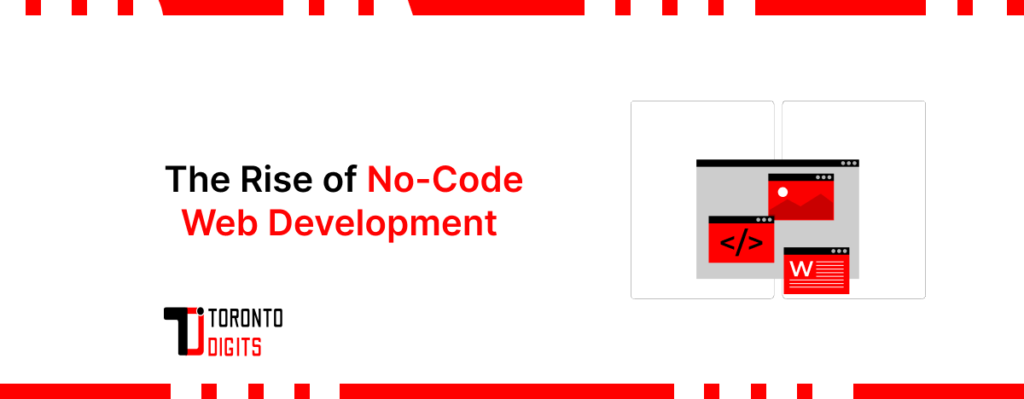The concept of no-code web development has emerged as a game-changer. No-code development platforms empower individuals without extensive coding knowledge to create powerful and functional web applications. This paradigm shift democratizes the process of web development, allowing entrepreneurs, businesses, and enthusiasts to bring their ideas to life without the need for traditional programming skills. The no-code impact on WordPress is also significant, as more users adopt visual builders and plugins instead of custom coding.
In this article, we delve into the phenomenon of no-code web development, exploring its origins, its impact on the industry, and its promising future. We’ll also look at no-code vs. traditional WordPress development, highlighting key differences in flexibility and learning curve, and compare MERN vs. no-code approaches for building scalable applications. As AI in no-code platforms continues to evolve, automation and smart design tools are further simplifying the development process. Finally, we touch on no-code alternatives to traditional development, offering insights into how these platforms are transforming the developer landscape.
Origins of No-Code Development
The roots of no-code development can be traced back to the early 2000s with the rise of visual programming languages and drag-and-drop interface builders. These tools aimed to simplify the software development process by abstracting complex code into visual components that could be manipulated without writing lines of code. However, it was not until recent years that the concept gained widespread attention and adoption.
The Emergence of No-Code Platforms
The proliferation of cloud computing, advancements in artificial intelligence, and the growing demand for rapid digital solutions have propelled the rise of no-code development platforms. Companies like Bubble, Webflow, and Wix have pioneered the movement by offering intuitive interfaces that enable users to design, build, and deploy web applications with ease. These platforms leverage pre-built templates, drag-and-drop functionality, and customizable components to streamline the development process, eliminating the need for coding expertise.
WordPress: Pioneering No-Code Web Development
In the landscape of no-code web development, one cannot overlook the significant role played by WordPress. Originally launched in 2003 as a blogging platform, WordPress has evolved into one of the most popular content management systems (CMS) in the world. Its intuitive interface and extensive library of plugins and themes have made it a go-to choice for individuals and businesses looking to create and manage websites without extensive coding knowledge.
WordPress democratized web publishing by providing users with a user-friendly platform to create and customize their websites without the need for specialized technical skills. Its success can be attributed to its open-source nature, which has fostered a vibrant community of developers and contributors who continuously enhance its functionality and extend its capabilities.
The Evolution of WordPress
Over the years, WordPress has undergone significant evolution, expanding beyond its roots as a blogging platform to become a versatile CMS capable of powering a wide range of websites, from simple blogs and portfolios to e-commerce stores and enterprise solutions. This evolution has been driven by advancements in technology, changes in user expectations, and the growing demand for flexible and customizable web solutions.
One of the key milestones in the evolution of WordPress was the introduction of the Gutenberg editor in 2018. Gutenberg replaced the traditional text editor with a block-based editor, allowing users to create rich and dynamic content layouts using pre-designed blocks such as text, images, videos, and more. This shift towards a more visual and intuitive editing experience aligned with the principles of no-code development, enabling users to design and customize their websites with greater ease and flexibility.
WordPress and the No-Code Movement
While WordPress may not fit the traditional definition of a no-code development platform, its impact on the democratization of web development cannot be overstated. By providing users with a powerful yet accessible tool for creating and managing websites, WordPress has paved the way for the broader adoption of no-code principles and practices.
Moreover, the ecosystem surrounding WordPress, including its vast repository of plugins, themes, and community support, further reinforces its role in the no-code movement. Users can leverage these resources to extend the functionality of their WordPress sites without writing a single line of code, whether it’s adding e-commerce functionality, implementing advanced SEO strategies, or integrating with third-party services.
Benefits of No-Code Web Development
No-code web development offers a myriad of benefits for individuals and businesses alike. One of the most significant advantages is the speed at which applications can be developed. With traditional coding methods, creating a web application from scratch can be a time-consuming process that requires specialized skills. No-code platforms drastically reduce development time by providing ready-made components and automating repetitive tasks.
Furthermore, no-code development lowers the barrier to entry for aspiring entrepreneurs and small businesses. Without the need to hire expensive developers or invest in extensive training, individuals can prototype and launch their ideas quickly and cost-effectively. This democratization of web development fosters innovation and entrepreneurship, allowing anyone with a vision to build and scale their digital ventures.
Moreover, no-code platforms offer scalability and flexibility, enabling users to iterate on their projects rapidly. As business requirements evolve and user feedback is received, developers can easily make changes to the application without rewriting code. This agility is crucial in today’s fast-paced digital landscape, where adaptability is key to staying competitive.
Transformation of Traditional Roles
The advent of no-code web development is not only revolutionizing the way applications are built but also transforming traditional roles within organizations. In traditional software development teams, the process typically involves distinct roles such as developers, designers, and project managers, each specializing in their respective domains. However, with the emergence of no-code platforms, these boundaries are blurring, giving rise to a new breed of “citizen developers” who possess a diverse skill set and can contribute to all aspects of the development process.
Citizen developers are individuals within organizations who leverage no-code platforms to create and deploy applications without formal training in software development. These individuals often come from non-technical backgrounds, such as marketing, sales, or operations, but possess a deep understanding of their organization’s needs and workflows. By empowering these individuals to take ownership of the development process, organizations can accelerate innovation, streamline workflows, and foster a culture of digital transformation from within.
Fostering Collaboration and Innovation: One of the most significant advantages of no-code web development is its ability to foster collaboration and innovation across departments and teams within an organization. Unlike traditional development methods that often require lengthy communication and coordination between developers, designers, and stakeholders, no-code platforms enable real-time collaboration through intuitive interfaces and visual feedback mechanisms.
For example, a marketing team looking to launch a new campaign can quickly prototype and iterate on a landing page using a no-code platform, soliciting feedback from stakeholders and making adjustments on the fly. Similarly, cross-functional teams can collaborate on complex projects, such as CRM integrations or workflow automation, without being hindered by technical barriers.
Moreover, the accessibility of no-code platforms encourages experimentation and exploration, as individuals feel empowered to test out ideas and iterate rapidly without fear of breaking code or disrupting existing systems. This culture of experimentation fuels innovation, as teams are encouraged to think outside the box and explore new ways of solving problems.
Challenges and Limitations
Despite its many advantages, no-code web development is not without its challenges and limitations. Critics argue that the reliance on pre-built components and templates can result in generic and cookie-cutter applications that lack uniqueness and sophistication. Additionally, complex functionalities and customizations may be challenging to implement within the constraints of a no-code platform, leading developers to resort to traditional coding methods.
Security and scalability are also concerns in the realm of no-code development. While platforms strive to provide robust security measures, the abstraction of underlying code can obscure potential vulnerabilities, making it difficult to conduct thorough security assessments. Similarly, as applications grow in complexity and user base, they may outgrow the capabilities of no-code platforms, necessitating a transition to custom-coded solutions.
Also Read: WordPress Theme Development for Beginners
Future Outlook
Despite these challenges, the future of no-code web development looks promising. As technology continues to advance, no-code platforms will become increasingly sophisticated, offering more advanced features and capabilities. Moreover, the growing community of no-code enthusiasts and developers will contribute to the expansion of knowledge and resources, further driving innovation in the field.
Moreover, the rise of no-code web development is not just a trend; it’s a movement towards inclusivity and accessibility in the tech industry. By eliminating the traditional barriers to entry, such as the need for coding expertise and substantial financial resources, no-code platforms open doors for a more diverse range of individuals to participate in digital innovation. This democratization of technology fosters creativity and diversity of thought, leading to the creation of solutions that address a broader spectrum of needs and perspectives.
Another key aspect of the future outlook for no-code web development is its integration with other emerging technologies. As artificial intelligence, machine learning, and automation continue to evolve, we can expect no-code platforms to leverage these technologies to enhance their capabilities further. For example, AI-driven features could automate repetitive tasks, provide intelligent suggestions for design and functionality, and even assist in troubleshooting and debugging.
Furthermore, the impact of no-code development is not limited to web applications. With the increasing demand for mobile apps, e-commerce platforms, and IoT solutions, no-code platforms are expanding their reach to cater to a diverse range of digital needs. This expansion opens up new opportunities for innovation and entrepreneurship across various industries, from healthcare and education to finance and entertainment.
Conclusion
In conclusion, the rise of no-code web development marks a significant shift in the way we conceive, design, and build digital solutions. By democratizing access to technology and empowering individuals to create without constraints, no-code platforms are driving a new era of innovation and inclusivity in the tech industry.
As we look towards the future, it’s clear that the potential of no-code development is limitless, offering endless opportunities for individuals and businesses to bring their ideas to life in the digital world.




